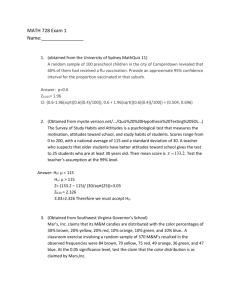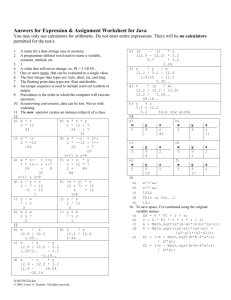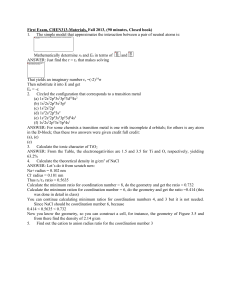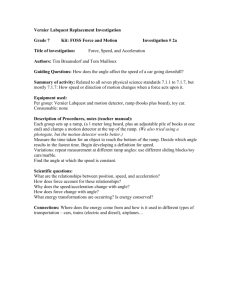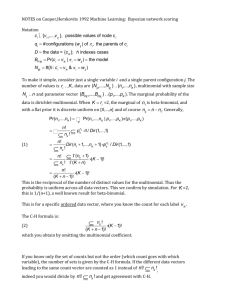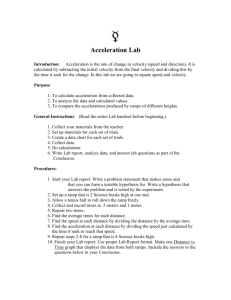A constant force is exerted for a short time interval on a cart that is
advertisement
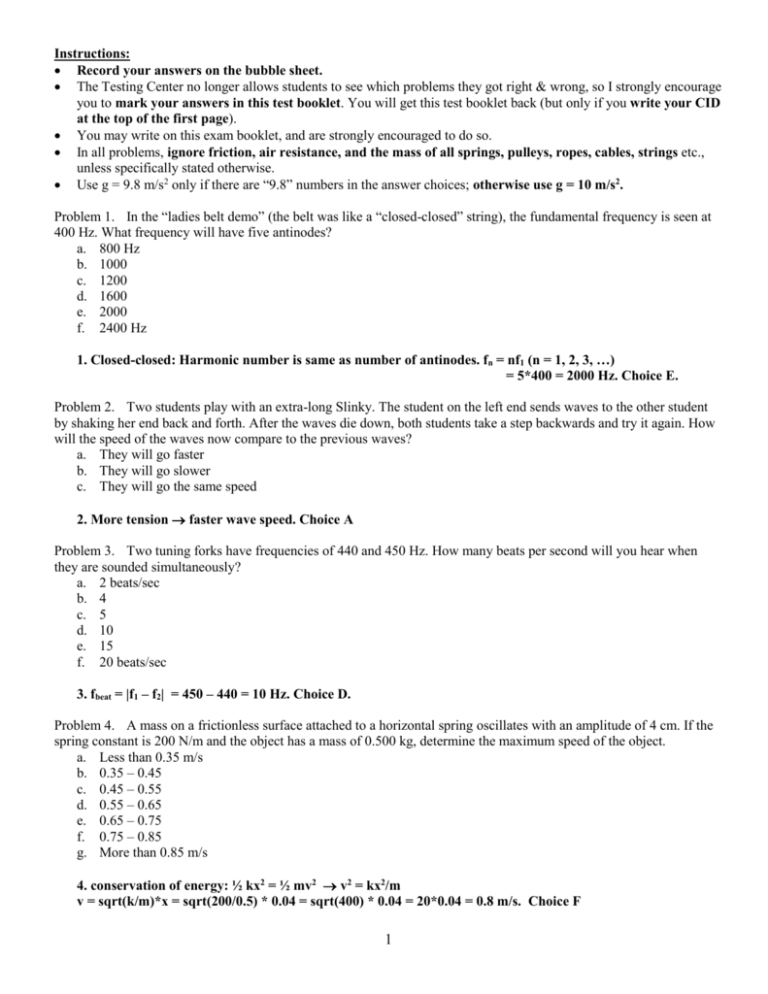
Instructions: Record your answers on the bubble sheet. The Testing Center no longer allows students to see which problems they got right & wrong, so I strongly encourage you to mark your answers in this test booklet. You will get this test booklet back (but only if you write your CID at the top of the first page). You may write on this exam booklet, and are strongly encouraged to do so. In all problems, ignore friction, air resistance, and the mass of all springs, pulleys, ropes, cables, strings etc., unless specifically stated otherwise. Use g = 9.8 m/s2 only if there are “9.8” numbers in the answer choices; otherwise use g = 10 m/s2. Problem 1. In the “ladies belt demo” (the belt was like a “closed-closed” string), the fundamental frequency is seen at 400 Hz. What frequency will have five antinodes? a. 800 Hz b. 1000 c. 1200 d. 1600 e. 2000 f. 2400 Hz 1. Closed-closed: Harmonic number is same as number of antinodes. fn = nf1 (n = 1, 2, 3, …) = 5*400 = 2000 Hz. Choice E. Problem 2. Two students play with an extra-long Slinky. The student on the left end sends waves to the other student by shaking her end back and forth. After the waves die down, both students take a step backwards and try it again. How will the speed of the waves now compare to the previous waves? a. They will go faster b. They will go slower c. They will go the same speed 2. More tension faster wave speed. Choice A Problem 3. Two tuning forks have frequencies of 440 and 450 Hz. How many beats per second will you hear when they are sounded simultaneously? a. 2 beats/sec b. 4 c. 5 d. 10 e. 15 f. 20 beats/sec 3. fbeat = |f1 – f2| = 450 – 440 = 10 Hz. Choice D. Problem 4. A mass on a frictionless surface attached to a horizontal spring oscillates with an amplitude of 4 cm. If the spring constant is 200 N/m and the object has a mass of 0.500 kg, determine the maximum speed of the object. a. Less than 0.35 m/s b. 0.35 – 0.45 c. 0.45 – 0.55 d. 0.55 – 0.65 e. 0.65 – 0.75 f. 0.75 – 0.85 g. More than 0.85 m/s 4. conservation of energy: ½ kx2 = ½ mv2 v2 = kx2/m v = sqrt(k/m)*x = sqrt(200/0.5) * 0.04 = sqrt(400) * 0.04 = 20*0.04 = 0.8 m/s. Choice F 1 Problem 5. The fundamental frequency (first harmonic) of the trumpet I brought to class is very close to 150 Hz. How long would its uncoiled length be? Take the speed of sound in air to be 300 m/s. (Hint: a trumpet is like an open-open pipe.) a. Less than 0.45 m b. 0.45 – 0.55 c. 0.55 – 0.65 d. 0.65 – 0.75 e. 0.75 – 0.85 f. 0.85 – 0.95 g. More than 0.95 m 5. open-open, for fundamental freq: L = ½ (think of picture) = ½ (v/f) = ½ (300)/150 = ½*2 = 1 m. Choice G Problem 6. A man wants to know the height of a tower, so he cleverly sets up a long pendulum extending from the top of the tower to the ground. He measures the period of the pendulum to be exactly 10 s. How tall is the tower? a. 170/2 m b. 190/2 c. 210/2 d. 230/2 e. 250/2 m 6. T = 2sqrt(L/g) L = (T/2)2 * g = (10/2)2*10 = (5/)2*10 = 250/ meters. Choice E. Problem 7. A family ice show is held at an enclosed arena. The skaters perform to music which is 80 dB where you sit. Your baby begins to cry, also with a level of 80 dB where you sit. What is the combined sound level? a. 80 dB b. 83 dB c. 86 dB d. 90 dB e. 120 dB f. 160 dB 7. 2 to intensity = +3 dB. Choice B. Problem 8. You have two pipes which produce sound: one is open at both ends (like a flute or an organ pipe) and the other is open at only one end (like a pan pipe or a bottle). If the two pipes have the same length, which will have the lower fundamental (first harmonic) resonant frequency? a. the open-open pipe b. the open-closed pipe c. they will have the same 8. For open-open fundamental, L = ½ . For open-closed fundamental, L = ¼ . (think of pictures) Therefore open-closed fundamental has the longer wavelength ( = 4L). Longer wavelength = smaller frequency. Choice B. Problem 9. A speaker emits spherical sound waves with a power output of 500 W. At what distance would you experience the sound at the threshold of pain, 120 dB? 105 meters a. b. 115 c. 125 d. 135 2 e. 145 f. 155 meters 9. First, what intensity is 120 dB? = 10log(I/10-12) I = 10-12 10/10 = 10-12 * 1012 = 1 W/m2 Now, I = Power/area = P/(4r2) r = sqrt(P/(4I) ) = sqrt(500/(4)) = sqrt(125/) meters. Choice C Problem 10. In the arrangement shown in the figure, an object of mass m = 10 kg hangs from a cord around a light pulley. The length of the cord between point P and the pulley is L = 2.0 m. When the vibrator is set to a frequency of 300 Hz, a standing wave with six antinodes is formed. What must be the linear mass density of the cord? a. Less than 2.6 g/m (note the units) b. 2.6 – 2.8 c. 2.8 – 3.0 d. 3.0 – 3.2 e. 3.2 – 3.4 f. More than 3.4 g/m 10. From the picture, L = 6*/2. So, = L/3 = 2/3 meter. Since v = *f, v = 2/3 * 300 = 200 m/s. Finally, since v = sqrt(T/) = T/v2 = 100N /(200 m/s)2 = 100/40000 = 1/400 kg/m = 1000/400 g/m = 2.5 g/m. Choice A. Problem 11. An object is moving back and forth in simple harmonic motion. Where is the acceleration of that object greatest? a. at the midpoint of the motion b. at the end points of the motion c. same value at every point 11. The spring force will be largest the farthest from equilibrium. Therefore the acceleration will be largest there, too. Choice B. Problem 12. A bat flying at 20 m/s emits a chirp at 35 kHz. If this sound pulse is reflected by a wall, what is the frequency of the echo received by the bat? Take the speed of sound in air to be 300 m/s. (Hint: This is exactly the same as the situation where the source and observer are both moving towards each other.) a. Less than 35 kHz b. 35 – 37 c. 37 – 39 d. 39 – 41 e. 41 – 43 f. More than 43 kHz 12. f = f (vvO)/(vvS). Since observer is moving towards source, pick + for numerator. Since source is moving towards observer, pick – for denominator. f = 35 kHz * (300 + 20)/(300 – 20) = 35*320/280 = 35 *32/28 = 35*8/7 = 5*8 = 40 kHz. Choice D. Problem 13. A ball is dropped down a well and takes 3 seconds to hit the bottom. How deep was the well? a. Less than 34 m b. 34 – 36 c. 36 – 38 d. 38 – 40 e. 40 – 42 f. 42 – 44 3 g. More than 44 m 13. y = ½ gt2 = ½ (10) (9) = 5*9 = 45 m/s. Choice G Problem 14. A block moves back and forth in a straight line, and has the position vs time graph given in the figure. Positive means “to the right”. How many times did the block turn around during this period of time? (“Turn around” means “change from moving right to moving left”, or vice versa.) a. 0 b. 1 c. 2 d. 3 e. 4 f. 5 g. 6 position 0.5 time 1 2 3 4 5 0.5 14. On a position graph, “turn arounds” happen where the slope goes to zero (changing from positive to negative slope, or vice versa). That occurs 5 times on this graph. Choice F. Problem 15. A certain sports car can accelerate at 1 g. How long will it take the car to go from 0 to 27 m/s? (Reference point: 27 m/s is just over 60 mph.) a. 2.0 – 2.2 seconds b. 2.2 – 2.4 c. 2.4 – 2.6 d. 2.6 – 2.8 e. 2.8 – 3.0 f. More than 3.0 seconds 15. vf = v0 + at 27 = 10t t = 2.7 s. Choice D Problem 16. A hiker follows her compass due north for 3 miles. She then veers right and follows a direction of 53.1° east of north (or 36.9° north of east) for 5 miles. How many miles is she from where she started? Note: sin(36.9) = 0.60, cos(36.9) = 0.80, tan(36.9) = 0.75; sin(53.1) = 0.80, cos(53.1) = 0.60, tan(53.1) = 1.33. a. 48 miles b. 50 c. 52 d. 54 e. 56 f. 58 miles 16. x vectors: 5*cos36.9 = 5*.8 = 4 y vectors: 3 + 5*sin36.9 = 3 + 5*.6 = 3+3 = 6 Pyth thm: distance = sqrt(42 + 62) = sqrt(16+36) = sqrt(52) miles. Choice C. Problem 17. A 50 kg ballet dancer jumps upward during a performance with an acceleration of 3 m/s2 in the time before she is air-born. What is the normal force between her feet and the floor during this time? a. Less than 520 N b. 520 – 550 c. 550 – 580 d. 580 – 610 4 e. 610 – 640 f. 640 – 670 g. More than 670 N 17. From FBD: N – mg = ma N = mg + ma = m(g+a) = 50(10+3) = 50*13 = 650. Choice F Problem 18. A monkey starts to slide down a rope. As it speeds up, it tightens its grip, until it slides at a constant velocity down the rope. Which of these choices is true now? a. The gravitational force is equal to the frictional force. b. The gravitational force is greater than the frictional force. c. The gravitational force is less than the frictional force. 18. If velocity is constant, forces are balanced (no net force). Choice A. Problem 19. The amount of potential energy possessed by an object that has been lifted up is equal to: a. the distance the object is lifted b. the force used to lift the object c. the object’s acceleration due to gravity d. the weight of the object e. the work done in lifting the object 19. Potential energy was designed to account for the work done by conservative forces. Choice E. Problem 20. You are a back-seat passenger in a car, not wearing your seat belt. Without increasing or decreasing its speed, the car makes a sharp left turn, and you find yourself colliding with the right-hand door. Which is the correct analysis of the situation according to Newton’s laws? a. Before and after the collision with the door, there is a rightward force pushing you into the door. b. Starting at the time of collision with the door, the door exerts a leftward force on you. c. Both of the above d. Neither of the above 20. Your own inertia seems to be making you go right, but this is a fictitious force. Once you hit the door, it pushes you less (otherwise you would go through the door). Choice B. Problem 21. You want to measure the spring constant of a spring, so you use it to fire a 40 g marble vertically. To do so, you compress the spring 3 cm then release it. The marble rises 90 cm above where it started. What is the spring constant, k? a. Less than 740 N/m b. 740 – 780 c. 780 – 820 d. 820 – 860 e. 860 – 900 f. 900 – 940 g. More than 940 N/m 21. Cons of energy ½ kx2 = mgh ½ k (0.03)2 = (0.040)*10*0.90 k = 2*0.04*9/(0.0009) = 2*0.04*10000 = 2*400 = 800 N/m. Choice C Problem 22. A block of mass m = 4 kg is held without moving on a frictionless incline of angle of 36.9 by the horizontal force F, as shown in the figure. Determine 5 the value of the force F, in Newtons. Note: sin(36.9) = 0.60, cos(36.9) = 0.80, tan(36.9) = 0.75. a. Less than 28.5 N b. 28.5 – 29.5 c. 29.5 – 30.5 d. 30.5 – 31.5 e. 31.5 – 32.5 f. 32.5 – 33.5 g. More than 33.5 N 22. Draw FBD. There are three forces: mg (straight down), F (straight right), and N (up & left). Equilibrium: all forces are balanced. If you divide forces into regular x-y axes: From x-components: N sin = F From y-components: Ncos = mg Divide: tan = F/mg F = mgtan = 40tan(36.9) = 40*(3/4) = 30 N. Choice C. If you divide forces into tilten x-y axes: From tilted x: mgsin (down incline) = Fcos (up incline) Divide by cos: F = mgtan. Same answer as other method. Note: I told the Testing Center to also accept choice B, which is what you get if you use g = 9.8 instead of 10. Problem 23. A baseball player, mass 40 kg, running at 5 m/s, slides to stop himself. If the friction coefficient between player and ground is , how far does he travel before stopping? a. Less than 2.0 m b. 2.0 – 2.1 c. 2.1 – 2.2 d. 2.2 – 2.3 e. 2.3 – 2.4 f. 2.4 – 2.5 g. More than 2.5 m 23. Ebef + W = Eaft KE – Wfriction = 0 ½ mv2 – f*d = 0 But force of friction = *N and N = mg (it’s not on an incline, and no other vertical forces are present) So: ½ mv2 – mg*d = 0 d = ½ mv2 /(*m*g). The m’s cancel D = ½ (25)/(0.65*10) = 12.5/6.5 = a little less than 2 (since 13/6.5 would be =2). Choice A Problem 24. A toy car on a ramp is given a quick upward push. As a result of the push, the car travels up the ramp a bit, then rolls back down again. As the car is moving up the ramp (after the push is over), the net force on it is: a. Up the ramp, and increasing in magnitude b. Up the ramp, and decreasing in magnitude c. Up the ramp, and constant d. Zero e. Down the ramp, and increasing in magnitude f. Down the ramp, and decreasing in magnitude g. Down the ramp, and constant 24. The net force is proportional to the net acceleration. If the velocity is going from “a lot up the ramp” to “a little up the ramp”, the direction of the change in velocity is “down the ramp”. Since the forces are not changing, this must be constant. Choice G. Problem 25. A man stands 2 m from the left end of a very light plank (consider it to be zero mass) that is 6 m long. A vertical support cable is attached to the right end of the plank, as shown. Calling the left end of the plank the “pivot 6 point”, how does the torque from the man’s force compare to the torque from the cable’s force? Just compare magnitudes. a. The torque from the man is equal to the torque from the cable. b. The torque from the man is greater than the torque from the cable. c. The torque from the man is less than the torque from the cable. d. It cannot be determined from the information given. 25. Equilibrium: sum of torques = 0. Calling the left end the pivot point, there are only two torques: one from the man (CW) and one from the cable (CCW). The two torques must be equal and opposite. Choice A. Problem 26. Same situation. How does the force from the man compare to the force from the cable? Just compare magnitudes. Just compare magnitudes. a. The force from the man is equal to the force from the cable. b. The force from the man is greater than the force from the cable. c. The force from the man is less than the force from the cable. d. It cannot be determined from the information given. 26. Since torque = force * distance, if the torques are equal but the distances are not, the forces are not equal. For the torques to be equal, a smaller distance means the force must be larger for the man. Choice B. Problem 27. A 20 kg pendulum bob passes through the lowest part of its path at a speed of 6 m/s. What is the tension in the pendulum cable at this point if the pendulum is 3 m long? a. Less than 415 N b. 415 – 425 c. 425 – 435 d. 435 – 445 e. 445 – 455 f. 455 – 465 g. More than 465 N 27. Sum of forces = m*ac T – mg = mv2/R T = mg + mv2/R = m (g + v2/R) = 20*(10+36/3) = 20*(10+12) = 20*22 = 440 N. Choice D. Problem 28. What would happen to g (currently 9.8 m/s2) if the mass of the earth were to be suddenly doubled (keeping the radius the same)? (Hint: Try to remember why g = 9.8 m/s2 at the surface of the Earth, in the context of Newton’s Law of Gravity.) a. g would stay the same b. g would increase by 2 c. g would increase by 4 d. g would increase by 8 28. Gravitational force = GMm/R2 from Newton’s law of gravity. Gravitational force also = mg, near the surface of the earth. Set them equal to each other: GMm/R2 = mg. The m’s cancel. g = GMearth/Rearth2 If the mass of the earth gets doubled, with R staying the same, g would be doubled. Choice B. Problem 29. The escape velocity of the Earth is the speed needed for an object to go from the surface of the Earth into a “near Earth” orbit. a. True b. False 29. Escape velocity is the speed needed to go from the surface of the earth to infinitely far away—not just to a near Earth orbit. False. Choice B. 7 Problem 30. A 2 kg mass moving east at 8 m/s on a frictionless horizontal surface collides with a 4 kg mass that is initially at rest. After the collision, the first mass moves due south at 4 m/s. What is the magnitude of the velocity of the second mass after the collision? a. 10 m/s b. c. d. 12 14 e. 18 f. 20 m/s 16 30. Cons of momentum x-direction: 2*8 = 4*vxfinal vxfinal = 4 m/s y-direction: 0 = -2*4 + 4*vyfinal vyfinal = 2 m/s Pyth theorem: vfinal = sqrt(42 + 22) = sqrt(16+4) = sqrt(20). Choice F. Problem 31. A string attached to a bucket (mass 6 kg) is wound over a large pulley having a mass of 16 kg (not zero mass!). The pulley can be considered to be a solid cylinder (aka a disk) of radius 0.5 m. The pulley turns as the block is allowed to fall from rest. No energy is lost to friction. If the bucket falls 73 m, how fast will it be going at the end? (Hint: the moment of inertia of a disk is given on page 1 of the exam.) 12 m/s a. 14 b. c. 16 d. 18 e. 20 22 m/s f. 31. Cons of energy PEbef = (KE + rotKE)aft mgh = ½ mv2+ ½ I2 mgh = ½ mv2 + ½ (½ MR2) (v2/R2) mgh = (½ m + ¼ M) v2 v2 = mgh/(½ m + ¼ M) = 60*7/3 / (3 + 4) = 60*(7/3) /7 = 60/3 = 20 m/s. Choice E. Problem 32. A satellite in the shape of a solid cylinder (aka a disk; end view shown in figure) of mass 30 kg and radius 3 m has a very small jet at the edge that provides a force of 50 N on the gasses it expels—and via Newton’s 3rd Law causes a force of 50 N to occur on the satellite in the opposite direction. What will be the magnitude of the angular acceleration of the satellite? (Hint: the moment of inertia of a disk is given on page 1.) a. Less than 0.4 rad/s2 b. 0.4 – 0.6 c. 0.6 – 0.8 d. 0.8 – 1.0 e. 1.0 – 1.2 f. 1.2 – 1.4 g. More than 1.4 rad/s2 32. sum of torques = I* 50*3 = (½ MR2)* 8 expelled gas 150 = ½ *30*32 * 150 = 15*9* 10 = 9* = 10/9 = 1.111 rad/s2. Choice E. Problem 33. A curved exit ramp (radius of curvature R = 20 m) is banked at a 36.87 angle. It is designed so that a car will not have to rely on friction to round the curve without slipping off; instead the centripetal acceleration will arise from a component of the normal force. What speed is the curve designed for? Note: sin(36.9) = 0.60, cos(36.9) = 0.80, tan(36.9) = 0.75. a. 130 m/s b. 140 c. 150 d. 160 e. 170 f. 180 g. 190 m/s 33. From FBD, Nsin is component that points towards middle of circle. Also, y-direction forces must balance since there’s no acceleration in y-direction. x-dir: Sum of forces = mac Nsin = mv2/R y-dir: Sum of forces = 0 Ncos = mg Divide: tan = v2/Rg v2 = tan *Rg = ¾ *20*10 = ¾ *200 = 150 v = sqrt(150) m/s. Choice C. Problem 34. An old-fashioned 1 liter glass milk jug is “empty” (still has air inside at 1 atm), at 300 K. You seal it, then put it into a fire at 700 K. The jug does not burst. What is the final pressure in the jug? a. Less than 1.8 atm b. 1.8 – 1.9 c. 1.9 – 2.0 d. 2.0 – 2.1 e. 2.1 – 2.2 f. 2.2 – 2.3 g. More than 2.3 atm 34. PV = nRT since V/nR = constant, P/T also = constant. P1/T1 = P2/T2 P2 = P1 (T2/T1) = 1 atm * (700/300) = 7/3 atm = 2.33 atm. Choice G. Problem 35. If the pressure of an ideal gas is reduced in a constant volume situation, the temperature of the gas must also go down. a. True b. False 35. True. Think of the ideal gas law, or of the temperature contour lines. Choice A Problem 36. A gas can be taken from state I to state F through three different processes as shown: via state A, via state B, and straight from I to F. See the given P-V diagram. In which process does the gas do the most amount of work? a. via A b. via B c. straight-line to F 9 d. same for all three e. cannot be determined from the information given 36. Work done by gas = area between the process line and the x-axis. The path from I to A will give you the most area. Choice A. Problem 37. An engine performs 500 J of work in each cycle and has an efficiency of 20%. How much energy is expelled as waste heat in each cycle? a. Less than 1100 J b. 1100 – 1500 c. 1500 – 1900 d. 1900 – 2200 e. 2200 – 2500 f. 2500 – 2800 g. More than 2800 J 37. e = W/Qh Qh = W/e = 500/0.2 = 500*5 = 2500 J. Qh = W + Ql Ql = Qh – W = 2500 – 500 = 2000 J. Choice D. Problem 38. Ralph is confused because he knows that when you compress gases, they tend to heat up. (Think of bicycle pumps.) Yet we talked about “isothermal” processes where the temperature doesn't change. How are such processes possible…how can you compress a gas without its temperature increasing? a. As long as you do not add heat to the gas, the temperature will stay constant. b. If you do work on the gas, it will compress isothermally. c. The heat added or subtracted can result in a change in the internal energy instead of a change in temperature. d. The heat that would be generated is transferred directly into thermal energy. e. The temperature will not increase if the pressure stays constant. f. You just have to increase the pressure while reducing the volume. g. You must remove heat from the gas at the same time you compress it. 38. If no heat flow is allowed, the gas will increase temperature as it’s compressed. Thus for the temperature to remain constant, heat must flow out of the gas. Choice G. Problem 39. A sealed room contains a mixture of helium (4 g/mole) and oxygen (32 g/mole) gas molecules at a temperature of 50 C and a pressure of 106 Pa (about 10 atm). Which will have the faster average speed? a. the helium molecules b. the oxygen molecules c. they will have the same average speed 39. From the “kinetic theory equation”, molecules with less mass will have a larger average speed. Choice A. Problem 40. First, a monatomic ideal gas (initial volume of 1.50 m3, initial temperature of 350 K) is compressed to 0.50 m3 via an isothermal process. Next, the gas is expanded again back to its original volume, keeping the pressure constant during this process. This increases the temperature of the gas to 1050 K. Which of the following diagrams best represents the two processes on a standard P-V diagram? a) b) c) d) e) f) g) h) 10 40. Isothermal compression = curved line up and to left. Constant pressure expansion = straight horizontal line to the right. Choice E. Problem 41. The 2nd law of thermodynamics is a statement of: a. conservation of energy b. conservation of (regular) momentum c. conservation of angular momentum d. conservation of mass/volume e. probability 41. The 2nd law says that it’s incredibly unlikely for heat to flow from hot to cold. Choice E. Problem 42. Substance X is a water-like substance with these properties: specific heat in its steam-like gas phase = 2,000 J/kgC specific heat in its water-like liquid phase = 5,000 J/kgC Lboiling/condensing = 1.0 105 J/kg Tboiling/condensing = 100 C An unknown mass of substance X, initially at 110 C, is added to an insulated 10 kg aluminum container initially at 30 C, and the two come to equilibrium at 80 C. How much substance X was there? (Hint: The substance X “steam” will turn into liquid during the process. The specific heat of aluminum is given on page 1.) a. Less than 2.0 kg b. 2.0 – 2.2 c. 2.2 – 2.4 d. 2.4 – 2.6 e. 2.6 – 2.8 f. 2.8 – 3.0 g. More than 3.0 kg 42. Qlost by X = Qgained by Al (mct)steam + (mL)steam to water + (mct)water = (mcT)Al Factor out an “m” from the left hand side: m*(2000 * 10 + 100000 + 5000*20) = 10*900*50 m*(20000 + 100000 + 100000) = 450000 m*(220000) = 450000 m = 45/22 = 2 1/22 = just a little more than 2 kg. Choice B. 11

